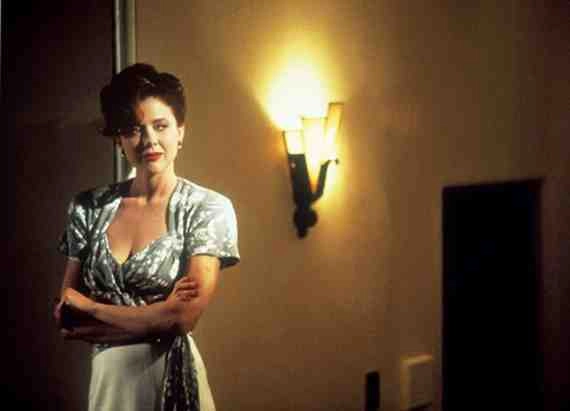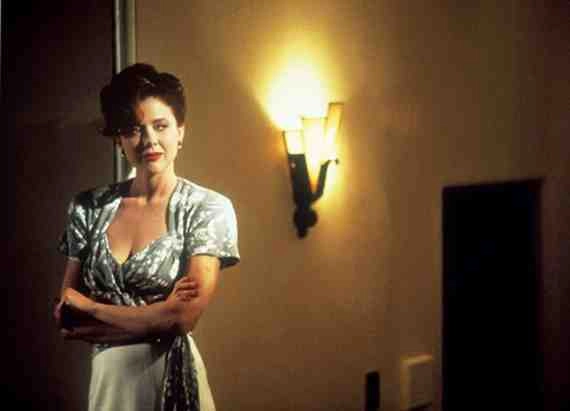Movies & TV
100 Greatest Gangster Films: Bugsy, #60
Annette Bening plays Virginia Hill, Bugsy Siegel’s lover and business partner in Bugsy. (1991-R)
© 1991 TriStar Pictures, Inc. All Rights Reserved.
“That kid’s name was Moe Greene. And the city he invented was Las Vegas. This was a great man, a man of vision and guts. And there isn’t even a plaque or a signpost or a statue of him in that town.”—Hyman Roth, The Godfather: Part II
Moe Greene, of course, did not invent Las Vegas. But the real-life mobster on whom his character is based—Benjamin “Bugsy” Siegel—did. Well, sort of.
And while Siegel suffered the same, sad fate that Moe Greene did (namely, a bullet through the eye), we are pleased to report that there is a plaque honoring him on the Vegas Strip, right on the site where he built the original Pink Flamingo Hotel & Casino in 1946.
There is also a movie honoring his life—Bugsy, starring Warren Beatty. The film portrays Siegel as both a visionary and a gangster. An innocent dreamer and a cold-blooded killer. An optimist and a cynic.
Beatty and director Barry Levinson go a little over the top at times trying to convince you what a lovable guy Siegel was. But the dichotomy of mobster/family man generally works, as it did so brilliantly in The Sopranos. Here is “Benny,” in his kitchen, wearing a goofy chef’s toque and icing a cake for his daughter’s birthday. Suddenly, the family celebration is interrupted by his partners—most notably Meyer Lansky (Ben Kingsley)—to discuss their nefarious business. With frosting smeared on his face, “Bugsy” explains to them how the mob can own Nevada.
This is a solid biopic, though, like most biopics, it bends the facts a bit. Bugsy Siegel did not really discover Las Vegas, as the movie portrays. His hotel was not the first on the Strip, but the third. And he did not build that from scratch but rather took over an unfinished project started by a degenerate gambler.
But what Siegel did was to envision Vegas with all the neon and naughtiness that would eventually define Sin City. Before he came along, casinos were Western saloons with sawdust on the floor and slot machines by the men’s rooms. Siegel installed wall-to-wall carpet, hired statuesque showgirls, and lured big-time acts like Al Jolson and Jimmy Durante from Hollywood.
That he robbed, cheated and murdered trying to realize that dream, well. . . .
Bugsy opens with Siegel’s move to California during World War II to run the New York mob’s interests, assisted by the vicious Mickey Cohen (Harvey Keitel). He visits a film set with an actor friend named George played by Joe Mantegna.
“My character is modeled after George Raft,” Mantegna said in an interview for this book. “I studied his work to get him down. In Bugsy, I’m reenacting a scene from Manpower, which Raft did with Marlene Dietrich. We studied that movie and tried to stage it exactly the same.”
As Mantegna’s character recites his lines, Siegel mouths them. He is smitten by the movies. He wants in.
He is also smitten by a bit-part actress, Virginia Hill, played by Annette Bening. For what it’s worth, Beatty and Bening fell in love filming this movie, resulting in their 1992 marriage and four children. Indeed, their on-screen chemistry appears convincing.
Anyway, Ms. Hill becomes more than Mr. Siegel’s paramour (his wife and children are back in Scarsdale, N.Y.). She becomes his business partner as they grow the Los Angeles operation and, soon enough, expand to Nevada. You’re not sure at times whether she’s really with him or just using him to further her own interests. In fact, you get the sense that she’s not really sure herself.
The back half of Bugsy focuses on Siegel’s grand vision for the Flamingo (named, by the way, in honor of Hill’s leggy figure) and the extraordinary cost overruns he accrued trying to get it built. His partners initially funded him $1 million for the project; in the end, it cost $6 million.
We don’t have to tell you what happens when you squander the mob’s money. And we’ve already given away how it ends for Siegel. Sitting in his Los Angeles living room, reading a newspaper, he is hit from behind by nine rifle shots fired from outside—the last of which passes through his left eye. By all accounts, it happened just that way in real life.
There’s a wonderful scene near the end when Bugsy senses what’s about to go down. On the phone with Lansky, his friend since childhood, he doesn’t beg for his life. Rather, he implores Lansky to never sell his own shares of stock in the Flamingo. The doomed man knew something. According to the movie’s postscript, “By 1991, the $6 million invested in Bugsy Siegel’s dream had generated revenues of over $100 billion.”
HIT: Director Levinson does a terrific job of showing the fashion, music, and lifestyle of Los Angeles in the 1940s, a place that appears so glamorous you almost forget there was a world war going on. We put Bugsy up there with Chinatown and L.A. Confidential in terms of recreating that city back in the day.
MISS: As breathtaking as Bening is as Virginia Hill, the character’s constant tantrums grow tiresome. Every other scene she’s stalking off in anger at some perceived indignation.
WHAT THEY WROTE AT THE TIME: “It would be easy to dismiss Bugsy as a phony Hollywood movie. Beatty seems an unlikely choice to play a Jewish gangster. The script is riddled with the kind of clever dialogue that happens only in movies. And Oscar-winning filmmaker Barry Levinson directs with a studied slickness. But Bugsy’s artifice has a seductive resonance. The film is, after all, about contrivance—about the folly of a man who lived and died for delusions of grandeur. The story is compelling. At times, it is wickedly funny.”—Brian D. Johnson, Maclean’s
DON’T FAIL TO NOTICE: What happens every time some unknowing fool refers to Siegel as “Bugsy.” Apparently, he always resented the nickname, which was given to him as a teenaged hood for being “as crazy as a bedbug.” His violent reaction does nothing to shake the moniker.
PIVOTAL SCENE: Siegel, Hill, and Mickey Cohen take their first trip to Nevada to visit the mob’s only casino. It’s a dusty, ramshackle joint, prompting Hill to crack, “We drove five-and-a-half hours for this canker sore?”
Siegel, too, is mortified, asking aloud, “Do we really want to be associated with this kind of dump?” He orders it closed down. “Looks matter,” he insists.
They bicker during the drive home, and Siegel becomes so infuriated that he skids the car to a halt and stomps into the desert in anger. Suddenly he stops and looks around. Raising his arms toward the setting sun, he appears to be drawing a skyline in the cactus-filled wilderness.
The Vegas Strip has come to his mind, “like a vision, like a religious epiphany.” Back home on the East Coast, he tells Lansky, “What do people always fantasize about? Sex, romance, money, adventure. I am building a monument to all of them.”
BEST LINE: Bugsy tries to explain the above concept to his cohorts:
Vito Genovese: “What are you talking about? A whorehouse?”
Bugsy: “No . . . I am talking about a place where gambling is involved, where everything is allowed. The whole territory is wide open. I’m talking about a palace, an oasis, a city. Do you know when the Hoover Dam is finished, electrical power is going to be available on a massive scale in Las Vegas?”
Vito: “I don’t get it. The Hoover Dam and fucking are connected how?”
Bugsy: “By air-conditioning. It’s the wave of the future.”
“I KNOW THAT GUY”: Mobster Charlie “Lucky” Luciano is played by legendary West Coast rock promoter Bill Graham. Two months before the film’s release, Graham was killed in a helicopter accident.
REALITY CHECK: As we said, most biopics take liberties with reality. And we’re not here to pick nits. But the postscript tacked onto the end of Bugsy states that “Virginia Hill committed suicide in Austria,” making it sound that her distraught gesture followed Siegel’s assassination. Sure it did—except it was 19 years later. Somehow that makes us believe the two acts were not connected.
CASTING CALL: Keitel, who plays Mickey Cohen here, actually portrayed Bugsy Siegel in the 1974 TV movie, The Virginia Hill Story.
VIOLENCE LEVEL: Sporadic. We will contend that Bugsy’s mauling of gangster Joey Adonis over an insult to Hill may be the top mob movie beatdown this side of Sonny’s attack on brother-in-law Carlo in The Godfather.
GOOF: Desperate for money to keep funding his hotel, Siegel sells his Los Angeles house and liquidates his furniture. But the movie’s final scene shows him getting murdered inside that same house, sitting on the same furniture he had already sold.
BET YOU DIDN’T KNOW: That house (at 810 Linden Drive, Beverly Hills) was long a fixture on Hollywood tours. Guides were eager to tell stargazers that after Siegel’s shooting, police found his intact eye 15 feet from his body.
BODY COUNT: A mere two, plus one more off-screen.
***
Join us as we count down the greatest gangster movies of all time — a new entry every Thursday! Click here to see what you’ve missed so far.
[Reprinted from The Ultimate Book of Gangster Movies by George Anastasia and Glen Macnow. Available from Running Press, a member of The Perseus Books Group. Copyright © 2011.]
Incoming search terms:
George Anastasia is a crime reporter for the “Philadelphia Inquirer” and author of several books, including “Blood and Honor” which Jimmy Breslin called “the best gangster book ever written.”
Glen Macnow was a writer for the “Philadelphia Inquirer” and “Detroit Free Press.” He is currently a talk-radio host on 610-WIP in Philadelphia.
George and Glen have co-authored “The Ultimate Book of Gangster Movies.”
Related
George Anastasia is a crime reporter for the "Philadelphia Inquirer" and author of several books, including "Blood and Honor" which Jimmy Breslin called "the best gangster book ever written." Glen Macnow was a writer for the "Philadelphia Inquirer" and "Detroit Free Press." He is currently a talk-radio host on 610-WIP in Philadelphia. George and Glen have co-authored "The Ultimate Book of Gangster Movies."








1 Comment
You must be logged in to post a comment Login